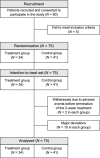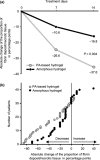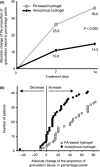Protease-modulating polyacrylate-based hydrogel stimulates wound bed preparation in venous leg ulcers--a randomized controlled trial
- PMID: 24612304
- PMCID: PMC4263240
- DOI: 10.1111/jdv.12400
Protease-modulating polyacrylate-based hydrogel stimulates wound bed preparation in venous leg ulcers--a randomized controlled trial
Abstract
Background: Stringent control of proteolytic activity represents a major therapeutic approach for wound-bed preparation.
Objectives: We tested whether a protease-modulating polyacrylate- (PA-) containing hydrogel resulted in a more efficient wound-bed preparation of venous leg ulcers when compared to an amorphous hydrogel without known protease-modulating properties.
Methods: Patients were randomized to the polyacrylate-based hydrogel (n = 34) or to an amorphous hydrogel (n = 41). Wound beds were evaluated by three blinded experts using photographs taken on days 0, 7 and 14.
Results: After 14 days of treatment there was an absolute decrease in fibrin and necrotic tissue of 37.6 ± 29.9 percentage points in the PA-based hydrogel group and by 16.8 ± 23.0 percentage points in the amorphous hydrogel group. The absolute increase in the proportion of ulcer area covered by granulation tissue was 36.0 ± 27.4 percentage points in the PA-based hydrogel group and 14.5 ± 22.0 percentage points in the control group. The differences between the groups were significant (decrease in fibrin and necrotic tissue P = 0.004 and increase in granulation tissue P = 0.0005, respectively).
Conclusion: In particular, long-standing wounds profited from the treatment with the PA-based hydrogel. These data suggest that PA-based hydrogel dressings can stimulate normalization of the wound environment, particularly in hard-to-heal ulcers.
© 2014 The Authors. Journal of the European Academy of Dermatology and Venereology published by John Wiley & Sons Ltd on behalf of European Academy of Dermatology and Venereology.
Figures






References
-
- O'Meara S, Cullum N, Nelson EA, Dumville JC. Compression for venous leg ulcers. Cochrane Database Syst Rev. 2012;11:CD000265. LID- 10.1002/14651858.CD. - PMC - PubMed
-
- Moffatt C, Morison MJ, Pina E. Wound bed preparation for venous leg ulcers. In: Moffatt C, editor. Wound bed preparation in practice. England: Oxford; 2004. pp. 12–17.
-
- Franks PJ, Moffatt CJ, Connolly M, et al. Factors associated with healing leg ulceration with high compression. Age Ageing. 1995;24:407–410. - PubMed
-
- Wysocki AB, Staiano-Coico L, Grinnell F. Wound fluid from chronic leg ulcers contains elevated levels of metalloproteinases MMP-2 and MMP-9. J Invest Dermatol. 1993;101:64–68. - PubMed
-
- Trengove NJ, Stacey MC, MacAuley S, et al. Analysis of the acute and chronic wound environments: the role of proteases and their inhibitors. Wound Repair Regen. 1999;7:442–452. - PubMed
Publication types
MeSH terms
Substances
LinkOut - more resources
Full Text Sources
Other Literature Sources
Medical

